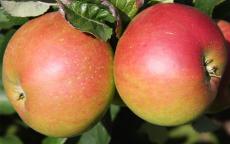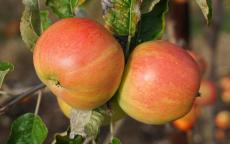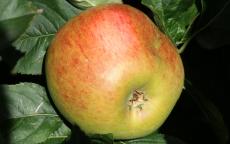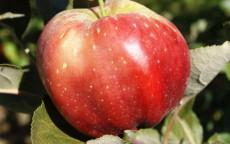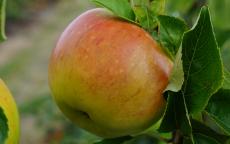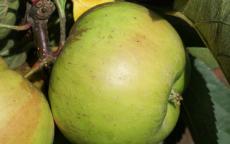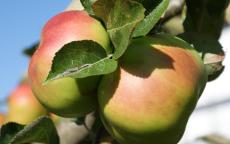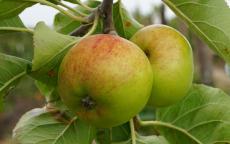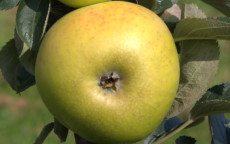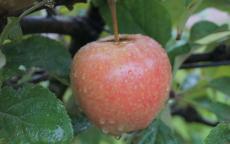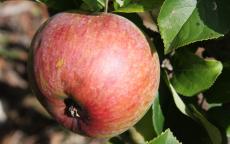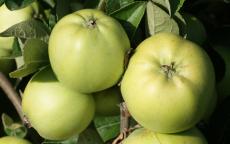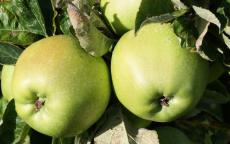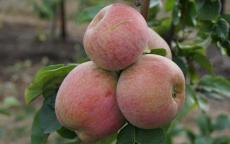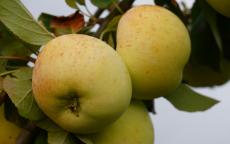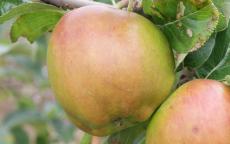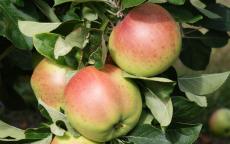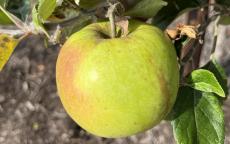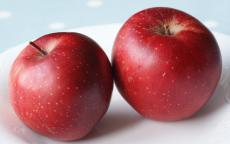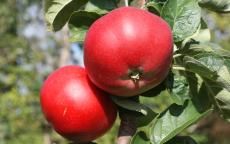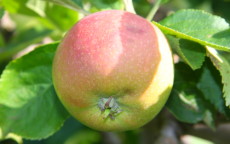- See also:
- Eating apples61
- Red-flesh apples4
- Cider apple trees12
Cooking apples
We have an extensive range of specialist cooking apple varieties, ideal for baking, apple pie, stewing, juicing, or for jams and preserves.
Annie Elizabeth
A traditional English cooking apple, with a sweet flavour, which keeps its shape when cooked.- Pick season: Late
- Keeping: 3 months or more
- Self-fertile?: Partially self-fertile
Arthur Turner
A mid-season cooking apple, producing a light yellow puree. Very attractive blossom.- Pick season: Mid
- Keeping: 2-3 weeks
- Self-fertile?: Not self-fertile
Bardsey
A hardy disease-resistant apple, discovered growing on an island off the west coast of Wales.- Pick season: Mid
- Keeping: 2-3 weeks
- Self-fertile?: Not self-fertile
Blenheim Orange
Blenheim Orange is a classic English dual-purpose apple, useful for dessert and culinary purposes.- Pick season: Late
- Keeping: 1-2 months
- Self-fertile?: Not self-fertile
Bloody Ploughman
An old Scottish apple variety, named for the crimson-red colour of its skin and stained flesh.- Pick season: Mid
- Keeping: 1-2 months
- Self-fertile?: Not self-fertile
Bountiful
Bountiful is an easy-to-grow cooking apple, it retains its shape when cooked, fairly sweet for a cooker.- Pick season: Mid
- Keeping: 1 week
- Self-fertile?: Not self-fertile
Bramley 20
Bramley 20 is a naturally smaller version of Bramley's Seedling (the apples are the same size though).- Pick season: Late
- Keeping: 3 months or more
- Self-fertile?: Not self-fertile
Bramley's Seedling
Bramley is the essential English cooking apple, famous for its rich sharp acidity.- Pick season: Late
- Keeping: 3 months or more
- Self-fertile?: Not self-fertile
Coul Blush
Coul Blush is an early-season dual-purpose apple from Scotland.- Pick season: Early
- Keeping: 1-2 months
- Self-fertile?: Not self-fertile
Galloway Pippin
A traditional Scottish cooking apple which keeps its shape when cooked.- Pick season: Late
- Keeping: 1-2 months
- Self-fertile?: Not self-fertile
Hidden Rose®
Hidden Rose is named for the unexpected pink flesh hidden behind the plain green skin.- Pick season: Very late
- Keeping: 1-2 months
- Self-fertile?: Not self-fertile
Howgate Wonder
Howgate Wonder is a large cooking apple which keeps well. Produces an excellent sharp juice.- Pick season: Late
- Keeping: 3 months or more
- Self-fertile?: Partially self-fertile
Keswick Codlin
Keswick Codlin is a popular early-season cooking apple, easy to grow, and productive in most climates.- Pick season: Early
- Keeping: 1 week
- Self-fertile?: Partially self-fertile
Lady Henniker
A well-regarded Victorian dual-purpose apple, easy to grow.- Pick season: Late
- Keeping: 3 months or more
- Self-fertile?: Not self-fertile
Lord Derby
Lord Derby is a high-quality mid/late-season traditional English cooking apple, cooks to a chunky puree.- Pick season: Late
- Keeping: 1-2 months
- Self-fertile?: Not self-fertile
Peasgood's Nonsuch
Peasgood Nonsuch is a highly-regarded old-fashioned English cooking apple.- Pick season: Mid
- Keeping: 2-3 weeks
- Self-fertile?: Partially self-fertile
Reverend W. Wilks
A widely-grown and well-regarded English cooking apple.- Pick season: Early
- Keeping: 2-3 weeks
- Self-fertile?: Self-fertile
Scotch Bridget
A popular Scottish cooking apple, well-suited to damp wet conditions.- Pick season: Late
- Keeping: 1-2 months
- Self-fertile?: Not self-fertile
Scotch Dumpling
Scotch Dumpling is a large Scottish cooking apple. Cooks to a frothy puree with a good flavour.- Pick season: Early
- Keeping: 2-3 weeks
- Self-fertile?: Not self-fertile
Stirling Castle
A traditional Scottish cooker from the Victorian era, with a good sharp flavour.- Pick season: Mid
- Keeping: 2-3 weeks
- Self-fertile?: Partially self-fertile
Tickled Pink
A new red-fleshed apple variety, with attractive crimson blossom, also known as Baya® Marisa.- Pick season: Late
- Keeping: 2-3 weeks
- Self-fertile?: Not self-fertile
Tom Putt
An old traditional English cider variety with a sharp juice, which can also be used for cooking.- Pick season: Early
- Self-fertile?: Not self-fertile
Warner's King
An 18th century English cooker which remains popular. Cooks to a sharp-flavoured puree.- Pick season: Late
- Keeping: 1-2 months
- Self-fertile?: Not self-fertile
How to choose Cooking apples
We've all grown up with Bramley cookng apples so we take it for granted that cooking apples are different to eating apples, but, surprisingly, the UK is one of the few countries that makes such a distinction between apples for cooking and apples for eating fresh.
The main qualtities of a good "cooker" are size - the bigger the better - and acidity. Counter-intuitively, it is the acid which gives cooking apples their flavour. In contrast the flavour of sweet dessert apples collapses with cooking.
Cooking apples are usually easier to grow than eating apples, and will tolerate partial shade.

